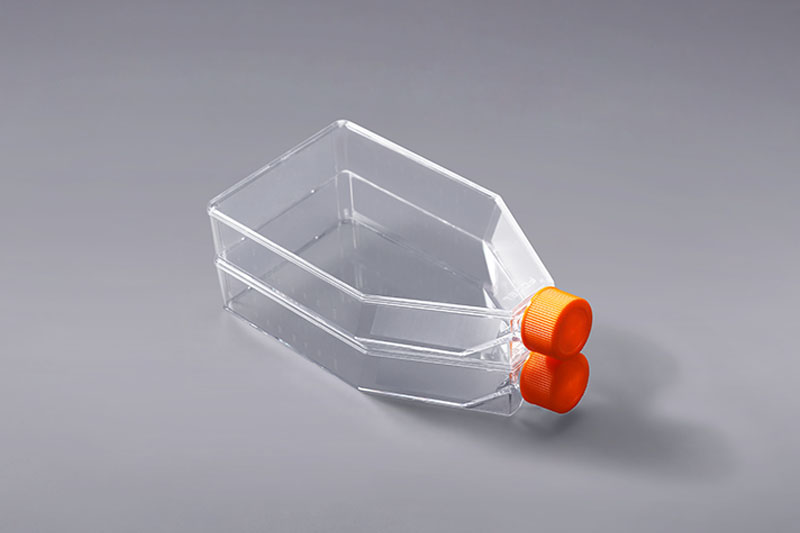सेल कल्चर जीवन विज्ञान के क्षेत्र में आमतौर पर इस्तेमाल की जाने वाली वैज्ञानिक अनुसंधान पद्धति है। सेल कल्चर फ्लास्क प्रयोगशाला में मध्यम स्तर के सेल टिशू कल्चर के लिए उपयुक्त उपभोज्य हैं। सेल कल्चर को बाँझ वातावरण में किया जाना चाहिए। सेल कल्चर के दौरान हम सभी प्रकार के प्रदूषण से कैसे बच सकते हैं?
सबसे पहले, सेल कल्चर के प्रदूषण स्रोत मुख्य रूप से तीन पहलुओं से आते हैं। एक ओर, रासायनिक प्रदूषण कुछ रासायनिक पदार्थों को संदर्भित करता है जो विषाक्त या कोशिकाओं को परेशान करते हैं। ये प्रदूषण आम तौर पर बिना धुले बर्तनों और अशुद्ध रासायनिक अभिकर्मकों से आते हैं। और खराब गुणवत्ता का आसुत जल। उनमें से, जीवाणु एंडोटॉक्सिन का कोशिका वृद्धि और प्रयोगात्मक परिणामों पर अधिक प्रभाव पड़ता है। यह नैदानिक गर्मी का मुख्य स्रोत है। दवाओं के उत्पादन की प्रक्रिया में क्लिनिकल दवाओं में सेल कल्चर द्वारा उत्पादित टीकों और साइटोकिन्स के उत्पादन से बचना चाहिए। विषाक्त पदार्थों का प्रदूषण। रासायनिक प्रदूषण को कम करने के लिए, उच्च गुणवत्ता वाले आसुत जल का उपयोग किया जाना चाहिए, और जितना हो सके डिस्पोजेबल सेल कल्चर जहाजों का उपयोग किया जाना चाहिए। खोजने में अपेक्षाकृत आसान है, और वायरस, माइकोप्लाज्मा और अन्य कोशिकाओं द्वारा संदूषण जो खोजने में अपेक्षाकृत कठिन हैं। उनमें से, वायरस संदूषण कण बेहद छोटे होते हैं, आम तौर पर कोशिकाओं में छिपे होते हैं, और संपूर्ण सेल संस्कृति के लिए घातक नहीं होते हैं, जो शोधकर्ताओं को वायरस से प्रभावित सेल परीक्षण के परिणाम प्राप्त करने की अनुमति दे सकते हैं। आमतौर पर, सेल कल्चर के संचालन के दौरान जैविक प्रदूषण होता है, इसलिए अच्छा सेल कल्चर ऑपरेटिंग वातावरण और संचालन की आदतें जैविक प्रदूषण को कम करने की कुंजी हैं। दूसरी ओर, प्रदूषण मुख्य रूप से अनुचित संचालन से संबंधित है। उदाहरण के लिए, कई प्रयोगकर्ता अपने हाथ नहीं धोते हैं और केवल शराब का छिड़काव करके प्रयोगशाला में प्रवेश करते हैं; सेल कल्चर स्क्वायर फ्लास्क और कल्चर सॉल्यूशन को होल्ड करते समय टोंटी वाले हिस्से को न पकड़ें; अल्ट्रा-क्लीन बेंच में बहुत सी चीजें हैं रुको। सेल प्रयोगों के परिणामों को प्रभावित करने से बचने के लिए सेल कल्चर प्रयोगों में उपरोक्त पहलुओं पर ध्यान दें।
On the other hand, there is biological contamination, including contamination by bacteria, molds and yeasts that are relatively easy to find, and contamination by viruses, mycoplasma and other cells that are relatively difficult to find. Among them, virus contamination particles are extremely small, generally lurking in cells, and are not lethal to the entire cell culture, which may allow researchers to obtain cell test results affected by the virus. Generally, biological pollution occurs during the operation of cell culture, so good cell culture operating environment and operating habits are the key to reducing biological pollution.
On the other hand, the pollution is mainly related to improper operation. For example, many experimenters do not wash their hands and enter the laboratory only by spraying alcohol; do not hold the bottleneck part when holding the cell culture square flask and the culture solution; there are too many things in the ultra-clean bench Wait. Pay attention to the above aspects in cell culture experiments to avoid affecting the results of cell experiments.
The FAI climbed 5.9 percent year-on-year in the first 11 months of 2018, quickening from the 5.7-percent growth in Jan-Oct, the National Bureau of Statistics (NBS) said Friday in an online statement.
The key indicator of investment, dubbed a major growth driver, hit the bottom in August and has since started to rebound steadily.
In the face of emerging economic challenges home and abroad, China has stepped up efforts to stabilize investment, in particular rolling out measures to motivate private investors and channel funds into infrastructure.
Friday's data showed private investment, accounting for more than 60 percent of the total FAI, expanded by a brisk 8.7 percent.
NBS spokesperson Mao Shengyong said funds into weak economic links registered rapid increases as investment in environmental protection and agriculture jumped 42 percent and 12.5 percent respectively, much faster than the average.
In breakdown, investment in high-tech and equipment manufacturing remained vigorous with 16.1-percent and 11.6-percent increases respectively in the first 11 months. Infrastructure investment gained 3.7 percent, staying flat. Investment in property development rose 9.7 percent, also unchanged.
 English
English



















































